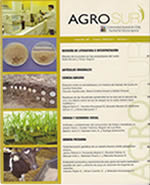Effect of transport of finished steers, fed with two levels of metabolizable energy, on their tympanic temperature as an indicator of well-being
Main Article Content
Abstract
The aim of this study was to assess the effect of a short transporting of finished steers fed with two levels of metabolizable energy on the pattern and time of recovery of tympanic temperature (TT) as an indicator of animal welfare. A tympanic temperature recording device was installed in twelve steers the morning of April 23 of 2014 (10:00 h). The device was programmed to record TT at 5-minute intervals. Half of the steers were fed a diet providing 1.85 times the metabolizable energy for maintenance (EMm), and the other half with a diet providing 2.72 times EMm. At 18:00 h, steers were herded from the pens and then transported to their final destination, 50 km away. The final data analysis was performed under a completely randomized design including repeated measure analysis (α=5%) on 7 animals because 5 devices were lost. Mean TT was higher in steers fed 2.72 times EMm (P <0.0001). A similar pattern on TT was observed in both groups. There was an interaction for EMm level x Day x Hour for TT (P <0.0001). Steers on higher EMm intake showed higher TT prior to 18:00 h, but thereafter those differences on TT disappear. These differences begin to be evident again from 09:00 h of the following day and until the end of the evaluation period. There were different recovery times of TT, depending on EMm intake, being lesser for those animals with higher EMm intake. The transporting of steers had an effect on the TT values independent of the level of EMm consumed.

